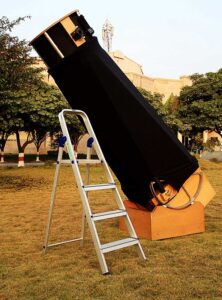
Make sure that the mirrors are reflective and you can’t see through them. Should I buy a Used Apertura AD8?Ī used Apertura AD8 Dobsonian is a wonderful scope.

Like most mass-manufactured Dobsonian telescopes, the AD8’s mount is made out of melamine-covered particle board and can be assembled in a few minutes with the included hex key. You can also adjust the friction by tightening two large knobs on the bearings. This can’t easily be done in the field, but it suffices for balancing with most stuff. The Apertura AD8’s altitude (up/down) bearings are ball bearings that can be adjusted back and forth along the tube to compensate for the telescope’s changing center of gravity, depending on what eyepieces/finders/etc. The scope is also prone to easily spinning around if it’s windy. This approach works fine, but it can be a bit hard to get the right amount of motion-a lot of people tend to complain that the scope is too stiff or spins too freely, which can make aiming and tracking with the telescope at high magnification a bit frustrating. The Almost Perfect Dobsonian Mountįor azimuth (side-to-side) movement, the Apertura/GSO Dobsonians use roller bearings, which are essentially a “lazy Susan.” This is different from most Dobsonians, which use Teflon pads and laminate arrangements. The included 1.25” “Moon filter” is complete junk-a piece of tinted green glass that dims the view at the expense of sharpness and turns everything green. However, it’s quite sharp, and 133x is enough for some nice views of the planets. Overall, the 9mm Plossl is a nice little addition.
#LARGEST DOBSONIAN TELESCOPE FULL#
This means you have to press your eye quite close to it to get the full view. The included 9mm Plossl is rather short on eye relief. Compared to the standard 25mm Plossl supplied with most other beginner scopes, the 30mm SuperView is a joy to use and is a great eyepiece for both general viewing of deep-sky objects as well as finding them. You could buy nicer eyepieces that have sharper stars and wider fields of view and a coma corrector to eliminate the coma, but at that point you’d be spending nearly as much as the whole scope costs. This is because of coma, which is a feature of any Newtonian telescope with an aperture of f/6 or faster, and astigmatism at the edge of the field with the eyepiece. You might notice that stars near the edges aren’t as clear. The included 30mm SuperView is a great low-power eyepiece. Otherwise, the laser may look dead on when your collimation is in fact quite far from correct. Seating it properly and squarely in the focuser is also very important. Without this work, the laser is little more than a decoration. However, for one thing, the laser itself is frequently out of square with the barrel when it arrives, requiring adjustments with a hex key and being placed in some sort of makeshift V-block to confirm it is parallel, which may be a bit of a headache for a lot of beginners.

The AD8 Dobsonian comes with a laser collimator that is supposed to make collimation easy. A zero-power red dot or reflex sight is easier to use and can complement or replace the 9×50 finder. But the confusion of using the 9×50 somewhat offsets these gains. Brighter deep-sky objects like the Andromeda Galaxy can be easily seen in the finder under light-polluted skies that make them invisible to the naked eye, along with stars down to 9th magnitude. This can be a bit confusing if you’re not familiar with the sky. You have to sight along the tube, then look into the finder to actually center the telescope on your target. The Apertura AD8’s included 9×50 finder works, but on its own it can be mildly frustrating to use to aim the telescope.


 0 kommentar(er)
0 kommentar(er)
